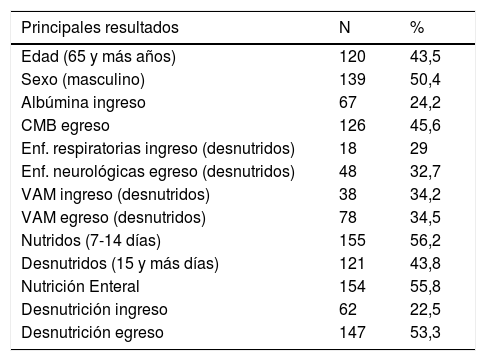Describir el estado nutricional de los pacientes al ingreso y al egreso, y estimar el riesgo de sufrir desnutrición al egreso de los pacientes graves, e identificar la carga causal de los factores predictivos en el desarrollo de la desnutrición al egreso.
Diseño, marco de referencia y pacientesSe realizó un estudio descriptivo, aplicado y explicativo en 276 pacientes que ingresaron en el Servicio de Cuidados Intensivos e Intermedios del Hospital Provincial Docente Clínico-Quirúrgico «Saturnino Lora» de Santiago de Cuba, desde marzo de 2012 hasta marzo de 2017.
MedicionesSe realizó un perfil nutricional, el cual incluyó indicadores antropométricos, bioquímicos e inmunológicos, y de acuerdo con los resultados de estos indicadores los enfermos se clasificaron en desnutridos y nutridos.
ResultadosReflejaron que la edad entre 65 y más años fue la predominante con un 43,5%, a su llegada al servicio el 22,5% (62 pacientes) de los pacientes presentaron desnutrición, aumentando esta cifra al egreso al 53,3% (147 pacientes). La presencia de sepsis aumenta el riesgo de desnutrición al egreso en un 620%, el análisis de desnutrición al egreso identificó mayor importancia para el periodo 2012-2014, con el 62% de los enfermos con esta condición.
ConclusionesLa desnutrición se erigió como un factor incidente en los pacientes graves al egreso, la sepsis es el factor principal que marca influencia causal sobre el estado nutricional de los enfermos y en el primer trienio la desnutrición fue más acentuada.
To describe the nutritional status of the patients on admission and at discharge from hospital, to estimate the risk of suffering malnutrition at discharge of critically ill patients, and to identify the causal load of the predictive factors in the development of malnutrition.
Design, framework, and patientsA descriptive, applied and explanatory study was carried out on 276 patients admitted to the Intermediate Care Unit and ICU of the Saturnino Lora Hospital in Santiago, Cuba, from March 2012 to March 2017.
MeasurementsA nutritional profile was performed, including anthropometrics, biochemical and immunological measurements. The results were used to classify the patients into under-nourished and normal.
ResultsThere was a predominance of the age between 65 and more years with 43.5%. On admission, 22.5% (62 cases) were undernourished, with this figure increasing to 53.3% (147 cases) on discharge. The presence of sepsis increases the risk of malnutrition on discharge in 62.0%. The nutrition analysis on discharge was found to be significant for the period 2012-2014, with 62.0% of the cases.
ConclusionsMalnutrition was shown to be an incidental factor in critically ill patients on discharge, with sepsis being the main factor that showed a causal influence on the nutritional status of ill patients, being more marked in the first three-year period.
Article
Socios de la Asociación de Medicina Crítica y Cuidado Intensivo
Para acceder a la revista
Es necesario que lo haga desde la zona privada de la web de la AMCI, clique aquí










